Editor's note: This article was translated from Spanish by Daniela Maria Ugaz and John Washington.
On Friday, June 11, David de la O disappeared. He was walking home from school in rural Santa Cruz Michapa, a small city in El Salvador about an hour’s drive from San Salvador, the nation’s capital. David’s family searched for him all night, without success. The next morning, his remains were found buried in an abandoned field outside town. He had been stabbed four times in the torso; his head, arms and legs had been severed. David was only 11 years old. In fourth grade, he had been learning long division and multiplication and practicing verb tenses. With no leads to go on, the police speculated that David was killed and dismembered by gang members because he refused to join their ranks. (He went to school in an area controlled by one gang and lived in a neighborhood dominated by another.)
David’s murder wasn’t widely reported in the country. It was yet another incident of violence—a terrible one, but one of many. The day before David was killed, two other teenagers, 15 and 16, had their throats slit and were dumped in another abandoned field on the outskirts of the capital.
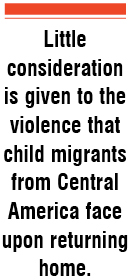 To avoid becoming the victims of gang violence, tens of thousands of children like David have fled El Salvador, Guatemala and Honduras for the United States. As their numbers skyrocket, lawmakers in Washington have sought to “repatriate” these refugees as quickly as possible. The Obama administration initially sought to change the 2008 Trafficking Victims Protection Reauthorization Act to allow the 52,000 or so child migrants who have arrived on US soil in the last nine months to be deported without going before an immigration judge. (Under the TVPRA, unaccompanied minors from countries that do not share a border with the United States are handed over to the Department of Health and Human Services, then go before an immigration court that will determine their fate; those hailing from Mexico, on the other hand, can accept “voluntary deportation” and return immediately.) The White House has since backed off this proposal and has instead asked Congress for $3.7 billion to ramp up enforcement and hire more judges to expedite the removal process. Republicans in the House of Representatives—including the GOP’s standard-bearer on immigration issues, Ted Cruz—continue to press for the TVPRA to be changed.
To avoid becoming the victims of gang violence, tens of thousands of children like David have fled El Salvador, Guatemala and Honduras for the United States. As their numbers skyrocket, lawmakers in Washington have sought to “repatriate” these refugees as quickly as possible. The Obama administration initially sought to change the 2008 Trafficking Victims Protection Reauthorization Act to allow the 52,000 or so child migrants who have arrived on US soil in the last nine months to be deported without going before an immigration judge. (Under the TVPRA, unaccompanied minors from countries that do not share a border with the United States are handed over to the Department of Health and Human Services, then go before an immigration court that will determine their fate; those hailing from Mexico, on the other hand, can accept “voluntary deportation” and return immediately.) The White House has since backed off this proposal and has instead asked Congress for $3.7 billion to ramp up enforcement and hire more judges to expedite the removal process. Republicans in the House of Representatives—including the GOP’s standard-bearer on immigration issues, Ted Cruz—continue to press for the TVPRA to be changed.
Popular
"swipe left below to view more authors"Swipe →
Little consideration has been given to the violence that children from these countries face upon returning home. But those who doubt that their lives are at risk are either deeply misinformed or, more likely, turning a blind eye to the epidemic of violence for the sake of political expedience. In the northern triangle of Central America, children are not only being killed, but brutally so—stabbed to death, cut into pieces, tortured.
But the violence in El Salvador, as in neighboring Guatemala and Honduras, has been going on for years. When President George W. Bush signed the TVPRA into law in 2008, there were fifty-two murders per 100,000 people in El Salvador. The number shot up to seventy-one in 2009 before plateauing at sixty-five. Then, thanks in part to a truce between the government and the gangs, it dropped sharply in 2012. That year, the Salvadoran government transferred thirty leaders of the two biggest gangs in the country, the 18th Street Gang and the Mara Salvatrucha, from maximum-security prisons to gang-segregated minimum-security prisons where inmates are allowed conjugal visits and visits from their children. As a result, in 2012 and 2013, the murder rate fell to around forty per 100,000. But the truce has been slowly falling apart as police have employed more aggressive tactics to deal with the still-rampant violence. This year, El Salvador has typically seen at least eight people murdered every day.
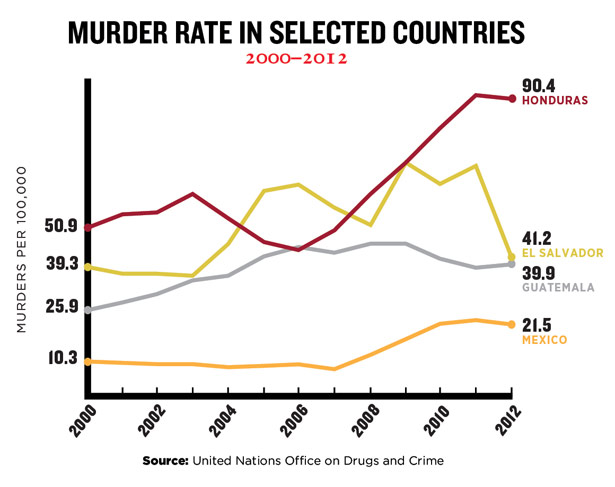
Violence is no less prevalent to the north or west. In 2013, the United Nations identified neighboring Honduras, which had ninety murders per 100,000 people in 2012, as the most violent country in the world. El Salvador was the fourth most violent; Guatemala, with forty murders per 100,000 people in 2012, the fifth.
Let’s put those numbers in perspective. The United Nations considers a rate of ten murders per 100,000 people an epidemic. If we were to apply the Honduran murder rate to New York City, where the yearly homicide rate is five per 100,000, more than 7,000 New Yorkers would be murdered per year. The rate of violence in Honduras is nearly twice that of America’s most violent city, Detroit, which has a homicide rate of fifty-five per 100,000.
Just as striking as these statistics is the consistently young age of the victims. According to El Salvador’s Institute of Legal Medicine, 38 percent of those murdered in the country every year are between the ages of 15 and 24. In the first three months of 2014 alone, 790 Salvadorans were killed, 306 of them between 15 and 24.
* * *
In a country with more than 6 million inhabitants, the 18th Street Gang and the Mara Salvatrucha have some 60,000 members, according to El Salvador’s Ministry of Security and Justice. Their presence is felt everywhere; they control entire neighborhoods, extorting regular fees from residents and business owners alike. In June, residents abandoned three apartment buildings in the capital because they could not afford to make monthly payments to the gangs. Gang violence is such a fixture of life here that the legislative assembly recently approved a change in the law that would allow those accused of murder—who, under Salvadoran law, are typically held in jail until police finish investigating the crime—to go free as the investigation proceeds if they can show that they acted to protect themselves from harm. Lawmakers said the change was necessary to provide the public with the “tools for self-defense.” Altogether, gang violence accounts for 40 percent of the murders in El Salvador and 27 percent of the overall crime.
The gangs not only recruit heavily among children, who act as messengers or drug runners because they are better able to evade detection by police; they are also recruiting younger and younger children. According to El Salvador’s National Public Security Council, the typical age at which children enter the gangs has dropped from 14 to 12. The Mara Salvatrucha recruits children as young as 8 or 9.
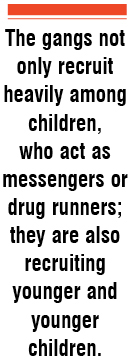 El Salvador’s minister of education has attributed the high dropout rate at many schools to gang recruitment. The gangs’ constant turf wars also keep some kids out of school. If a school is in an area controlled by the Mara, the gang will not allow children who live in neighborhoods controlled by the 18th Street Gang (known in El Salvador as Barrio 18) to attend. Students in some areas must carry backpacks made of transparent plastic to ensure that they are not carrying weapons, and they are searched by police before entering classrooms.
El Salvador’s minister of education has attributed the high dropout rate at many schools to gang recruitment. The gangs’ constant turf wars also keep some kids out of school. If a school is in an area controlled by the Mara, the gang will not allow children who live in neighborhoods controlled by the 18th Street Gang (known in El Salvador as Barrio 18) to attend. Students in some areas must carry backpacks made of transparent plastic to ensure that they are not carrying weapons, and they are searched by police before entering classrooms.
As the case of David de la O shows, saying no to a gang can be dangerous, and hiding is nearly impossible. For many, the best option—and in some cases, the only option—is to flee.
In 2009, I met three brothers traveling through Mexico on their way to the United States. Auner, the eldest, was 20. His siblings, who went by Chele and Pitbull, were 16 and 17. They had decided to flee El Salvador after violence came knocking at their door. First, two gang members were killed right outside of their home. Then their mother, who sold snacks on the sidewalk and had witnessed the murder, was killed by a gunshot wound to the head a few months later. Auner’s explanation for leaving is straightforward: “I’m running because I’m scared they’re going to kill me.” As with many of the children I met during the three years I spent reporting on migration through Mexico, Auner and his siblings had nowhere near the $7,000 to pay a coyote to take them to a relative in the United States. They had to leave El Salvador on their own, traveling by bus, staying in hostels, and navigating the treacherous journey on the advice of fellow migrants. I accompanied them until they reached the city of Oaxaca in south-central Mexico. Last I heard, they were on the outskirts of Mexico City; without a peso in their pockets, they planned to hop aboard a cargo train headed north.
As thousands of children like Auner, Chele and Pitbull arrive at the US border, it is important to remember the role the United States has played in creating this mass migration. In the 1970s and ’80s, El Salvador, Guatemala and Honduras were in the midst of either bloody civil wars or fierce government repression in which the United States played an iron-fisted role. Fearing the spread of communism in Latin America, the United States supported the autocratic military governments of these three countries, which in turn generated thousands of northbound migrants. Some of these migrants went on to join gangs in California. The 18th Street Gang and the Mara Salvatrucha were not formed in El Salvador, Honduras or Guatemala but in the United States. Some fifty years ago, the 18th Street Gang splintered off from Clanton 14 in Southern California. The Mara Salvatrucha formed in Los Angeles in the late 1970s. At the end of the ’80s and the start of the ’90s, the United States deported close to 4,000 gang members. When they arrived back in Central America, they found fertile conditions in which to increase their numbers: countries devastated by war and poverty, with thousands upon thousands of corruptible and abandoned children.
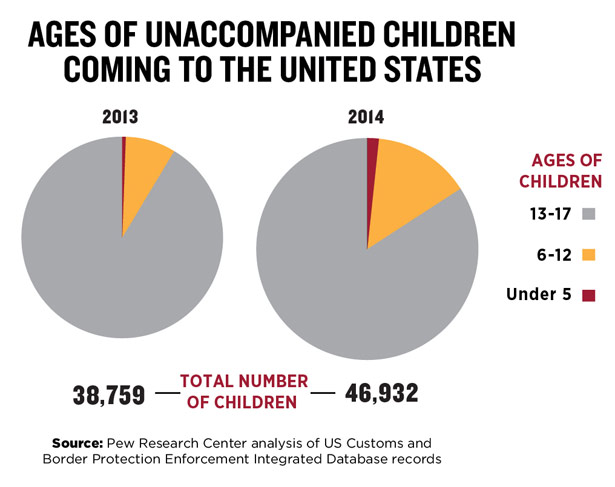
But it would be an oversimplification to say that the flight of children to the United States is the product of violence alone.
Rubén Zamora is currently the Salvadoran ambassador to the UN and, until a month ago, El Salvador’s ambassador to the United States. With his replacement awaiting confirmation by the Salvadoran Senate, Zamora has been left to address the international implications of the child migrant crisis. Zamora explains that there is no single cause of the surge in child migrants. In addition to gang activity, Zamora says that the improving economic conditions experienced by Salvadoran migrants to the United States have acted as a draw. “From sharing a single room with a group of people, now some migrants can pay $1,000 a month and rent a two-bedroom apartment for themselves in the suburbs,” he says. And that means “more people can pay to bring their children to the US.”
Thousands of migrants from Central America are ineligible for temporary protected status—not because they’ve violated any law but because they missed the cutoff dates. The United States offers a mere 5,000 visas for low-skilled workers every year. For many, the only chance for gaining legal status in the United States is the asylum process, and it’s a long shot. Over the last few decades, in part as a response to the wave of Central American migrants fleeing the civil wars, the United States has narrowed the definition of who qualifies for asylum. Because most of those fleeing Central America are not doing so because of their “race, religion, nationality, membership in a particular social group, or political opinion,” they are ineligible.
I recently asked two immigration lawyers from California and North Carolina how many requests for asylum they file each week. “At least ten,” they said. They’ve lost track of how many migrants they’ve represented over the years. But the tally of those who have been successful is easy to remember: none.
“Parents don’t see any chance of bringing their children legally to the US,” Zamora says, “so what options are left for them?”
The case of Sandra, a Salvadoran woman who migrated to the United States eleven years ago, is typical. She crossed without papers and remains undocumented. Working at a laundromat in Maryland, she isn’t wealthy. But she has been able to save enough money to bring her children across. Two years ago, she paid a coyote $7,000 to bring her 15-year-old daughter to the States. A month ago, Sandra hired another to bring her 12-year-old son as well. The coyote gave her two options: she could pay $7,500 for her son to be brought to Maryland, or $4,500 for him to be taken to the US-Mexico border, where he would be handed over to the US Border Patrol. The coyote assured Sandra that he knew how the laws worked and that her son would eventually be turned over to her. Sandra chose the cheaper option. But the child was caught by authorities in southern Mexico and deported back to El Salvador.
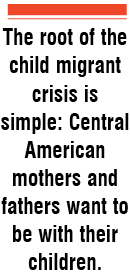 Sandra knows she doesn’t have a chance to get papers legally. She wouldn’t even qualify for a visa if comprehensive immigration reform were to pass. And yet she is a mother who wants to be close to the child she hasn’t seen in eleven years.
Sandra knows she doesn’t have a chance to get papers legally. She wouldn’t even qualify for a visa if comprehensive immigration reform were to pass. And yet she is a mother who wants to be close to the child she hasn’t seen in eleven years.
Sandra is originally from La Unión in eastern El Salvador, where gang members have begun charging extortion fees in her former neighborhood. The gangs, she hears, are closing in on her son.
I asked her if she would try again to bring her son to the United States. “Yes,” Sandra said.
The root of the child migrant crisis is simple: undocumented Central American mothers and fathers want to be reunited with their children. And because they don’t see an end to the violence that is rapidly encroaching on their kids in Honduras, El Salvador or Guatemala, these parents have only one option—coyotes.
* * *
On Wednesday, July 9, I paid a visit to a coyote at his house in Chalatenango in northern El Salvador. This coyote, who wishes to remain anonymous—I’ll call him “José”—is one of the oldest veterans of his profession. A man of over 50, stout like a tree, José explains that coyotes used to be beloved figures in their communities rather than vilified. “People would greet you on the streets, bring you gifts,” he says. “Today, many see you as a criminal because so many new coyotes engage in deception.”
José started guiding people to the United States when it wasn’t illegal to do so—at least not in El Salvador. His career took off in 1979 amid the escalating civil war. At the time, he would publish ads promoting his business in newspaper classified sections. Safe trips to the United States, a typical ad announced. This coyote has never used the train known as “The Beast” to cross Mexico and reach the US border; his methods are safer and his services more expensive. He ferries migrants north using a chain of Central American and Mexican coyotes whose movements he coordinates by phone. They travel by bus and pay bribes to Mexican police officers and Border Patrol agents with whom they have established “agreements.” He charges $7,500 per person.
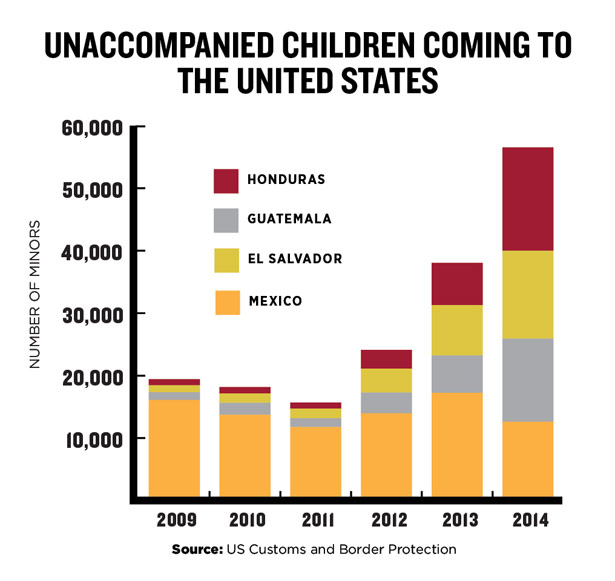
I ask José how he would explain this new wave of migrant children. “I laugh when the media says children are going by themselves. Not one of them goes alone—all of them are taken by coyotes,” he boasts. “If I were undocumented in the US, how am I going to tell my kid, ‘Come on over!’ No, that’s not how it goes.”
José no longer advertises in the papers; these days, his clients are referred to him by word of mouth, which has an astounding power in the world of migrants. Despite the tremendous distances traveled by them—and the dozens of US cities in which they live and hide without papers—these migrants seek each other out, they congregate, they gather at the same restaurants and send remittances to their families in Central America. Most working-class Central Americans either know a coyote personally or know someone who knows one. If a mother in Los Angeles sees that her neighbor’s children have made it into the States, she will want her own kids to come as well; then another mother will do the same, and then another and then another, until you have 52,000 children crossing the border.
In the United States, coyotes are generally perceived as ruthless criminals on the level of narco-traffickers. But those fleeing the violence in their native countries would make that trek with or without them; what the coyotes do is make the journey easier. They are part of our communities, and often they’re our only hope. Tragically, evidence suggests that for most Central American families separated by the treacherous expanse of Mexico, the possibilities for reunification remain almost nil.
José thinks there will be a mass crackdown on coyotes in Central America, triggered by US pressure. Ambassador Zamora confirms that Salvadoran President Sánchez Cerén has circulated instructions for such a crackdown in his country. José thinks the United States might call for the extradition of certain Central American coyotes, an idea that to Ambassador Zamora does not seem outside the realm of possibility. One thing is certain: the Obama administration’s record number of deportations has only given coyotes like José new customers.
Of the $3.7 billion President Obama has requested from Congress to deal with the child migrant crisis, only $295 million will be set aside for the governments of El Salvador, Honduras and Guatemala to better control their borders and create conditions to ameliorate the lead causes of mass migration. If we assume that a budget represents a government’s vision, then the US government believes that its responsibility to Central America in this crisis amounts to less than 8 percent. But the violence in Central America is far more than 8 percent of the problem.
The United States is not looking into creating a family reunification visa, nor has it announced any plans to grant asylum or refugee status to thousands of children who risk death in Central America if they return. Instead, the US government plans to continue deporting immigrants and financing Central American governments to combat their coyotes and better patrol their borders.
Cracking down on coyotes will surely slow the flood of children coming to the United States for a time. The Obama administration may also approve quicker methods for deporting children, which will diminish the flow as well. But none of these policies get to the heart of the matter. Central American mothers and fathers will continue to seek ways to be reunited with their children; they will continue to try to get them out of violent places and keep them safe. And if no one offers a better alternative, coyotes will continue to be their only way to do this. The children will not stop coming.


